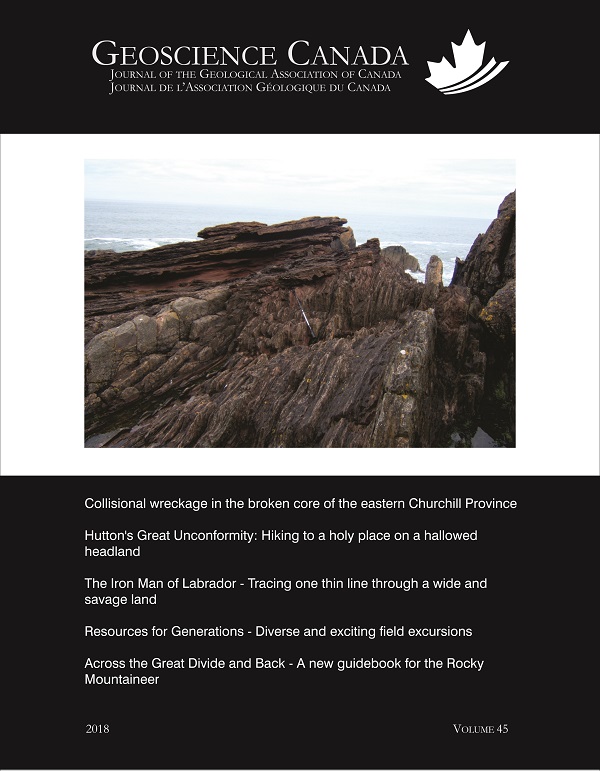Series
Classic Rock Tours 1. Hutton’s Unconformity at Siccar Point, Scotland: A Guide for Visiting the Shrine on the Abyss of Time
Publié-e 2018-04-20
Comment citer
Kerr, A. (2018). Classic Rock Tours 1. Hutton’s Unconformity at Siccar Point, Scotland: A Guide for Visiting the Shrine on the Abyss of Time. Geoscience Canada, 45(1), 27–42. https://doi.org/10.12789/geocanj.2018.45.129
Résumé
The angular unconformity at Siccar Point in Scotland is one of the most famous localities in the history of geology. At this spot, steeply dipping, folded turbiditic sandstone of early Silurian age is clearly overlain by subhorizontal red conglomerate, breccia and sandstone of late Devonian age. Siccar Point was not the first unconformity ever to be described or illustrated, but it is unquestionably one of the most spectacular and informative that geologists are likely to see. In June of 1788, a famous excursion by James Hutton, John Playfair and Sir James Hall first discovered this striking evidence for the cyclic nature of geological processes and the probable antiquity of the Earth. Contrary to myth, it was likely not the inspiration for Hutton’s famous phrase no vestige of a beginning, no prospect of an end, but Playfair’s metaphor of looking so far into the abyss of time is forever associated with this place. Siccar Point influenced many other geologists, including the young Charles Lyell, who would eventually bring the ideas of James Hutton together with those of William Smith, to build the uniformitarian paradigm that founded modern geology. Lyell’s writings would in turn influence the young Charles Darwin in his search for the reality and causes of evolution. Siccar Point is easy to visit from the historic and vibrant city of Edinburgh, and such a pilgrimage is easily combined with other sights of geological or cultural interest. Visiting the shrine involves a short coastal hike in one of the most beautiful parts of Scotland. This article combines practical advice for would-be pilgrims to Siccar Point with some historical context about its pivotal role in the development of geological ideas in the enlightenment of the late 18th and early 19th centuries.RÉSUMÉ
La discordance angulaire de Siccar Point en Écosse est l'une des localités les plus célèbres de l'histoire de la géologie. À cet endroit, un grès turbiditique plissé à fort pendage du début du Silurien est recouvert de conglomérats rouges subhorizontaux, de brèches et d’un grès de la fin du Dévonien. Siccar Point n'est pas la première discordance qui ait été décrite ou illustrée, mais c'est sans conteste l'une des plus spectaculaires et révélatrices que les géologues puissent voir. En juin 1788, avec leur célèbre excursion, James Hutton, John Playfair et Sir James Hall ont découvert cette preuve frappante de la nature cyclique des processus géologiques et de l`ancienneté probable de la Terre. Contrairement à ce qu'on croit, ce n'est probablement pas la fameuse phrase de Hutton « aucun vestige d'un début, aucune perspective de fin », mais la métaphore de Playfair « voir si loin dans l'abîme du temps » qui est à jamais associée à ce lieu. Siccar Point a influencé de nombreux autres géologues, y compris le jeune Charles Lyell, qui a fini par réunir les idées de James Hutton et celles de William Smith qui ont défini le paradigme uniformitariste, devenu le fondement de la géologie moderne. Les écrits de Lyell influenceront à leur tour le jeune Charles Darwin dans sa recherche de la réalité et des causes de l'évolution. Il est facile de se rendre à Siccar Point depuis cette ville chargée d'histoire et dynamique qu’est Édimbourg, et un tel pèlerinage se combine facilement avec d'autres sites d'intérêt géologique ou culturel. La visite de ce « sanctuaire » implique une courte randonnée côtière dans l'une des plus belles régions d'Écosse. Le présent article combine des conseils pratiques pour les visiteurs potentiels à Siccar Point et présente un historique de son rôle central dans le développement des idées géologiques à la fin du XVIIIe siècle et au début du XIXe siècle.
